Monday, April 16, 2007
We are all ....
Saturday, April 14, 2007
Not just a good idea -- it's the law.
In the summer of 1977, my parents' car was rear-ended on a suburban street in Connecticut. Fortunately for everyone involved, the accident happened at low speed. However, not only were my parents not wearing their seat belts, but my father, whose war against the mechanical world was lifelong and unrelenting, had for some reason removed the front-seat headrests. Both of my parents ended up with classic whiplash injuries, and my mother had pain in her back and neck for months. The other driver, also unbelted, was painfully banged up when he collided with his dashboard.
A bit less than a year later, a couple of guys from my dorm were in a car accident in Cambridge, Massachusetts. The driver, who had worn his seat belt, was unhurt. The unbelted passenger had the presence of mind to wedge his leg against the dash at the moment of impact, which saved his head and face. Of course, it didn’t do much good for his leg, which broke in several places. While his friends had fun at the beach that summer, he sat around in a cast instead.
In 1984, an affable fortyish engineer in my department walked into the office a bit stiffly one morning. The previous evening, he’d been driving through an intersection in a Boston suburb when another driver had run a light and smacked into his car. The seat belt restrained the engineer as he flew forward in his seat, leaving a bruise that ran from left shoulder to right hip. But my co-worker was in reasonably good humor about the whole thing; a bruised torso was a lot less of an inconvenience than a fractured skull would have been.
A few days before Christmas that same year, my seat belt kept me from bouncing around the inside of my car when a careless driver cut in front of me on the Masspike, the car ahead of him had to brake for traffic, and when I slammed on my own brakes to avoid what would have been a hard rear-end collision, my own subcompact whirled around several times in the left lane and then flew off the road and onto the median. My only injury was the bloody scratch I got on my thumb when, pumped with post-spinout adrenaline, I ripped the keys out of the ignition. With the help of the tow truck that pulled me out of the mud, I got home a bit late and under my own power, rather than as the worse-for-wear guest of a Sturbridge-area ambulance service.
And, several years ago, my father-in-law and nephew, securely belted into the front seat of my father-in-law’s beloved old Chevy, completely escaped injury when a distracted driver ran into them in suburban Indianapolis.
Astute readers by now have figured out that this post was inspired by what happened to Governor Jon S. Corzine of New Jersey on Thursday night. My personal hope is that Gov. Corzine recovers swiftly and completely from his injuries. I’d wish him the same even if he weren’t a member of the political party for which I normally cast my votes. But I suspect that the guy is a real piece of work to have for a boss. You have to wonder about someone – even a successful politician – who lives with such an illusion of control that he not only doesn’t normally comply with his own state’s seat belt laws, but has been known to chew out the state trooper on his guard detail for gently suggesting that he buckle up.
This is past being a mere technicality of law in New Jersey, where seat belt scofflaws are subject to a $20 fine. The problem is that if you’re driving or riding around unbuckled when your car has a close encounter with another solid object, you’re going to have to answer to a higher power. You know which one I mean – it’s the one normally expressed as F = ma. What you want to do is prevent your m from undergoing a lot of a, because that great big F on the left side of the equation is not your friend, no matter by how much you outrank the state trooper sitting beside you in the vehicle.
An accident of that severity is every driver’s nightmare, and no one “deserves” to be severely injured because of willful carelessness, but I think that an example still needs to be made of Gov. Corzine, and the suggestion that he be subjected to the customary fine doesn’t go far enough. I think he should be sentenced to a very specific kind of community service, preferably to be served as soon as he’s sufficiently recovered to speak in front of a camera, but well before he’s released from the hospital. And, it should go something like this:
I’m Governor Jon S. Corzine of New Jersey, and I’m here to tell you to wear your seat belt. I didn’t wear mine, and now I’m in the hospital recovering from multiple internal injuries and at least sixteen broken bones. And I was lucky, because when the accident happened, I had an entourage of police officers who were all trained in advanced first aid and were able to get an ambulance to the scene right away. If I’d been driving alone, as many of you frequently do, I might have bled to death before help reached me.
I’m a tough old ex-Marine, a wealthy businessman, and an elected official with a lot of clout. I’m about as powerful a man as you’ll find in politics. But I made a mistake that is completely beyond my power to take back, and it was worse than just violating the New Jersey seat belt law. That alone will get you a $20 fine, and some embarrassment if you’re a public figure. But I scoffed at the laws of physics, and now it’ll take months of therapy before I can walk without crutches. I scared my kids half to death. And I’ll probably have to live with some physical effects of this accident for the rest of my life.
One of the people in the car with me was only slightly injured, and the other was completely unhurt. Don’t do what I did – do what they did. Buckle up.
He’d save some lives, for sure. At a time when we need political figures to bring us back to a reality-based world, things don’t get much more reality-based than this.
A bit less than a year later, a couple of guys from my dorm were in a car accident in Cambridge, Massachusetts. The driver, who had worn his seat belt, was unhurt. The unbelted passenger had the presence of mind to wedge his leg against the dash at the moment of impact, which saved his head and face. Of course, it didn’t do much good for his leg, which broke in several places. While his friends had fun at the beach that summer, he sat around in a cast instead.
In 1984, an affable fortyish engineer in my department walked into the office a bit stiffly one morning. The previous evening, he’d been driving through an intersection in a Boston suburb when another driver had run a light and smacked into his car. The seat belt restrained the engineer as he flew forward in his seat, leaving a bruise that ran from left shoulder to right hip. But my co-worker was in reasonably good humor about the whole thing; a bruised torso was a lot less of an inconvenience than a fractured skull would have been.
A few days before Christmas that same year, my seat belt kept me from bouncing around the inside of my car when a careless driver cut in front of me on the Masspike, the car ahead of him had to brake for traffic, and when I slammed on my own brakes to avoid what would have been a hard rear-end collision, my own subcompact whirled around several times in the left lane and then flew off the road and onto the median. My only injury was the bloody scratch I got on my thumb when, pumped with post-spinout adrenaline, I ripped the keys out of the ignition. With the help of the tow truck that pulled me out of the mud, I got home a bit late and under my own power, rather than as the worse-for-wear guest of a Sturbridge-area ambulance service.
And, several years ago, my father-in-law and nephew, securely belted into the front seat of my father-in-law’s beloved old Chevy, completely escaped injury when a distracted driver ran into them in suburban Indianapolis.
Astute readers by now have figured out that this post was inspired by what happened to Governor Jon S. Corzine of New Jersey on Thursday night. My personal hope is that Gov. Corzine recovers swiftly and completely from his injuries. I’d wish him the same even if he weren’t a member of the political party for which I normally cast my votes. But I suspect that the guy is a real piece of work to have for a boss. You have to wonder about someone – even a successful politician – who lives with such an illusion of control that he not only doesn’t normally comply with his own state’s seat belt laws, but has been known to chew out the state trooper on his guard detail for gently suggesting that he buckle up.
This is past being a mere technicality of law in New Jersey, where seat belt scofflaws are subject to a $20 fine. The problem is that if you’re driving or riding around unbuckled when your car has a close encounter with another solid object, you’re going to have to answer to a higher power. You know which one I mean – it’s the one normally expressed as F = ma. What you want to do is prevent your m from undergoing a lot of a, because that great big F on the left side of the equation is not your friend, no matter by how much you outrank the state trooper sitting beside you in the vehicle.
An accident of that severity is every driver’s nightmare, and no one “deserves” to be severely injured because of willful carelessness, but I think that an example still needs to be made of Gov. Corzine, and the suggestion that he be subjected to the customary fine doesn’t go far enough. I think he should be sentenced to a very specific kind of community service, preferably to be served as soon as he’s sufficiently recovered to speak in front of a camera, but well before he’s released from the hospital. And, it should go something like this:
I’m Governor Jon S. Corzine of New Jersey, and I’m here to tell you to wear your seat belt. I didn’t wear mine, and now I’m in the hospital recovering from multiple internal injuries and at least sixteen broken bones. And I was lucky, because when the accident happened, I had an entourage of police officers who were all trained in advanced first aid and were able to get an ambulance to the scene right away. If I’d been driving alone, as many of you frequently do, I might have bled to death before help reached me.
I’m a tough old ex-Marine, a wealthy businessman, and an elected official with a lot of clout. I’m about as powerful a man as you’ll find in politics. But I made a mistake that is completely beyond my power to take back, and it was worse than just violating the New Jersey seat belt law. That alone will get you a $20 fine, and some embarrassment if you’re a public figure. But I scoffed at the laws of physics, and now it’ll take months of therapy before I can walk without crutches. I scared my kids half to death. And I’ll probably have to live with some physical effects of this accident for the rest of my life.
One of the people in the car with me was only slightly injured, and the other was completely unhurt. Don’t do what I did – do what they did. Buckle up.
He’d save some lives, for sure. At a time when we need political figures to bring us back to a reality-based world, things don’t get much more reality-based than this.
Monday, February 19, 2007
Order of the Science Scouts ...
Here are my earned badges. Clicking on the badge image should display a description; if that doesn't work for any reason, you can click here to get to the main page that will explain what's going on.
This would become a very long post if I described each one, so if you want to know what I did to earn them, just leave a comment and I'll answer it in the thread.
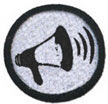




















This would become a very long post if I described each one, so if you want to know what I did to earn them, just leave a comment and I'll answer it in the thread.





















Sunday, February 04, 2007
Not a bug post, but here's what's going on in my life
For the first time in approximately 25 years, I’m attempting to go on a diet.
It’s not what you think. For instance, it’s not necessarily a low-calorie diet, although I expect it to do good things for my weight. It’s not a low-fat or a low-carb diet, although I’m sure I’ll consume less sugar and grease in the process. It’s not a vegetarian diet, although it will be primarily plant-based. And, it’s not tied to a specific religious or ethnic culture, although it would probably not be alien to any of my ancestors.
In short: I’m going to make the attempt, as much as is humanly possible, to eat food and only food.
If you follow the above link to a New York Times essay by Michael Pollan, you’ll learn exactly what I mean. (Free registration may be required, and the essay’s a bit long, but it’s an easy read as well as a refreshing one.) For those who don’t have the time to follow the link, it can be paraphrased as follows: If a supposedly edible item is extensively processed, extruded, colored, flavored, laced with alleged “nutritional supplements”, and heavily promoted as a novel high-tech invention, it’s probably not food.
In other words: Before you start counting fats, carbs, calories, vitamins, minerals, antioxidants, and claims of disease prevention, try losing the medicated corn chips and the space-shuttle-ready cereal bars in favor of real vegetables, whole grains, and fruits. If you eat animal products (I do), go for the ones that contain the fewest medicines and additives, and exercise moderation. If you must occasionally eat refined and processed foods, stick with the ones that have a tradition that goes back at least a few generations before your own. At least they have a track record of not killing people.
We still have some items in our house that don’t qualify as food under the above definition. We’re finishing them off, although whenever we read the labels on the frozen prefabricated veggie burgers and the shiny wrapped energy bars, we’ve been gleefully exclaiming “It’s not food!” The soy milk will undoubtedly stay; soy beverages have been around for centuries, and soy milk is easier than real dairy on Rick’s allergies and my lactase-deficient digestive tract. I’ve actually found a recipe for a meatless sausage-like patty that’s made out of real food – tempeh, beans, and natural herbs and spices – and plan to give it a try in the near future. For those carnivorous mornings, I’ve found a naturally low-fat turkey bacon produced without nitrites or drug-laced feed.
So, watch this space. It will be interesting to see how this turns out. I tend to be a sucker for weird food, whether it’s real food or not, so the big difficulty for me won’t be resisting the reconstituted potato-flake chips or the omega-enhanced eggs. Those things are old hat. The problem is that whenever someone introduces a rice-syrup sweetened vitamin-enhanced celery-derived toaster pastry that supposedly cures the common cold and tastes exactly like rhubarb pie, I’m the kind of person who has to try it at least once. With luck I’ll break that habit. Pass the real rhubarb pie, and I’m sure I’ll enjoy a moderately-sized piece, guilt-free.
It’s not what you think. For instance, it’s not necessarily a low-calorie diet, although I expect it to do good things for my weight. It’s not a low-fat or a low-carb diet, although I’m sure I’ll consume less sugar and grease in the process. It’s not a vegetarian diet, although it will be primarily plant-based. And, it’s not tied to a specific religious or ethnic culture, although it would probably not be alien to any of my ancestors.
In short: I’m going to make the attempt, as much as is humanly possible, to eat food and only food.
If you follow the above link to a New York Times essay by Michael Pollan, you’ll learn exactly what I mean. (Free registration may be required, and the essay’s a bit long, but it’s an easy read as well as a refreshing one.) For those who don’t have the time to follow the link, it can be paraphrased as follows: If a supposedly edible item is extensively processed, extruded, colored, flavored, laced with alleged “nutritional supplements”, and heavily promoted as a novel high-tech invention, it’s probably not food.
In other words: Before you start counting fats, carbs, calories, vitamins, minerals, antioxidants, and claims of disease prevention, try losing the medicated corn chips and the space-shuttle-ready cereal bars in favor of real vegetables, whole grains, and fruits. If you eat animal products (I do), go for the ones that contain the fewest medicines and additives, and exercise moderation. If you must occasionally eat refined and processed foods, stick with the ones that have a tradition that goes back at least a few generations before your own. At least they have a track record of not killing people.
We still have some items in our house that don’t qualify as food under the above definition. We’re finishing them off, although whenever we read the labels on the frozen prefabricated veggie burgers and the shiny wrapped energy bars, we’ve been gleefully exclaiming “It’s not food!” The soy milk will undoubtedly stay; soy beverages have been around for centuries, and soy milk is easier than real dairy on Rick’s allergies and my lactase-deficient digestive tract. I’ve actually found a recipe for a meatless sausage-like patty that’s made out of real food – tempeh, beans, and natural herbs and spices – and plan to give it a try in the near future. For those carnivorous mornings, I’ve found a naturally low-fat turkey bacon produced without nitrites or drug-laced feed.
So, watch this space. It will be interesting to see how this turns out. I tend to be a sucker for weird food, whether it’s real food or not, so the big difficulty for me won’t be resisting the reconstituted potato-flake chips or the omega-enhanced eggs. Those things are old hat. The problem is that whenever someone introduces a rice-syrup sweetened vitamin-enhanced celery-derived toaster pastry that supposedly cures the common cold and tastes exactly like rhubarb pie, I’m the kind of person who has to try it at least once. With luck I’ll break that habit. Pass the real rhubarb pie, and I’m sure I’ll enjoy a moderately-sized piece, guilt-free.
Thursday, November 30, 2006
I've been a bad, bad bug blogger!
Stridulations has obviously been gathering spider webs for a while. Though I'd like to be a prolific blogger, other parts of my life sometimes become entirely too hectic, and when that happens, the e-bugs just have to wait in a long, long line.
I'm trying to devote a lot of time to my research right now, as well as to searching for my next job. (I won't be blogging about the latter, since it's really one of those things that's best kept confidential.) Yup, I do have a backlog of photos from Panama, Rochester, and Montreal. Nope, not sure when they'll get posted.
I would like to keep Stridulations going, and I'm extremely indebted to the people who keep checking out this site. I can't promise frequent updates right now, but please do keep dropping by!
Cheers,
-- Julie
I'm trying to devote a lot of time to my research right now, as well as to searching for my next job. (I won't be blogging about the latter, since it's really one of those things that's best kept confidential.) Yup, I do have a backlog of photos from Panama, Rochester, and Montreal. Nope, not sure when they'll get posted.
I would like to keep Stridulations going, and I'm extremely indebted to the people who keep checking out this site. I can't promise frequent updates right now, but please do keep dropping by!
Cheers,
-- Julie
Thursday, September 07, 2006
Montreal Insectarium, take one
I'll start things rolling with some Montreal Insectarium photos. These are all pix of posed or pinned, preserved specimens; I'll save the live ones for later.
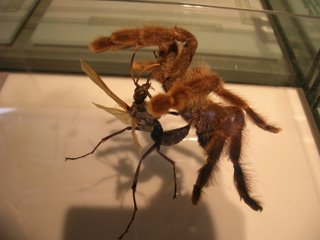
Pepsis wasp attacking a tarantula.

Flat-bodied carabid beetle under bark. The visible portion of this insect was at least 5 cm long.
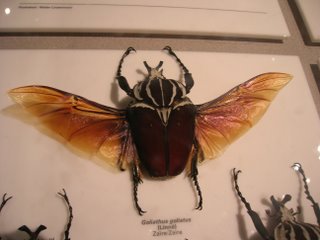
What does a goliath beetle wear under its elytra? Why, another pair of wings, of course!

This is an African uraniid moth, a relative of the one I photographed in Panama.

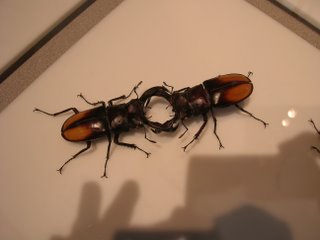
Lucanid (stag) beetles making love and war.

Pepsis wasp attacking a tarantula.

Flat-bodied carabid beetle under bark. The visible portion of this insect was at least 5 cm long.

What does a goliath beetle wear under its elytra? Why, another pair of wings, of course!

This is an African uraniid moth, a relative of the one I photographed in Panama.


Lucanid (stag) beetles making love and war.
Monday, September 04, 2006
Steve Irwin, 1962-2006

My husband and I became Steve Irwin fans one New Year’s Eve in Kalamazoo, Michigan. A cable network was celebrating the holiday by showing three or four back-to-back documentaries about snakes. It was a cold night and we had no other plans, so we watched the whole lineup. The capstone episode featured a manic blond Australian dude wrangling a wild menagerie of venomous elapids, and obviously enjoying the experience. We were hooked.
Biologists have always had, at best, mixed feelings about Steve Irwin. For one thing, he wasn’t a scientist. Instead, Irwin was a showman, a complete ham in front of the camera. Every Australian I’ve ever met has had the same response to Irwin’s American popularity that most Americans have when we hear about the alleged French estimation of Jerry Lewis. And, of course, no one really knows the effects that Stevo’s mano-a-mano interaction with animals actually had on the critters themselves. It wasn’t a scientific approach to conservation, nor was it ever meant to be.
The reason that I always felt a kinship with Steve Irwin had nothing directly to do with science, and everything to do with why I’m in science now. There are people who are so in love with other species that they have to interact with them constantly. You see it sometimes in expert gardeners among their plants. I’ve seen it in a Michigan naturalist, himself a picture of scientific focus, who smiled as he explained that he loved banding the birds he retrieved from mist nets because it permitted him “an anthropomorphic experience with the birds”. If you’ve seen any of the TV work of Georges Brossard (the “Bug Man” of the Montreal Insectarium) or any of the nature series of Jeff Corwin or Sir David Attenborough, you’ll recognize that same joy of interaction when your host is on camera.
I have it too. Anyone who knows me knows that I just can’t keep my hands off bugs. I love to touch butterflies and beetles. I used to let my giant African millipedes walk up my arm. I’ve poked a finger into the nests of biting Allegheny mound ants in order to experience their nipping mandibles and formic acid spray. I smile when Drosophila land on me in the lab. And most of my friends have, at one time or another, seen me pet a bumble bee on the thorax. I’ve even touched paper wasps and bald-faced hornets when the weather is a little chilly and the insects aren’t reacting quickly.
Most of these arthropods aren't really dangerous, but I wonder sometimes what I would do if I ever experienced a life-threatening reaction to a hymenopteran venom. Would I still study wasps and ants? Would I still pet bumble bees in the garden? My answer: I honestly don’t know. Most likely, I wouldn’t stop doing any of those things. On the one hand, I like to think that I’m very good at anticipating what a familiar insect will do. On the other, I have no illusions that I can actually control the way any live animal will react to me. I also don’t know whether touching a nectaring bee has any deleterious effect on the bee or its nestmates. But, my scientific curiosity is only part of the reason why I work with insects. I love them, and I have to be around them, the same way Steve Irwin loved his snakes and crocodiles.
On the morning of August 14, 2004, my husband and I dragged ourselves out of bed early at a friend’s place in Brisbane, so that we could catch the train to Beerwah and Australia Zoo. We had landed in Australia only the day before. I was so exhausted that I experienced bouts of vertigo all day and had trouble standing up straight. But, it was the only day we could schedule the trip, so we went to the zoo anyway. The staff would never actually tell you whether Steve was there. We didn’t see him. For a photo-op, we had to settle for the cutout shown above. It’ll have to do now, permanently.
I don’t encourage my readers to pet bumble bees; as much as I think they’re unlikely to sting under those circumstances, I can’t promise you that you won’t get stung that way. Reptile expert Jeff Corwin was once badly envenomated by a coral snake that he wasn’t even attempting to handle. Snakes and crocodiles and, sadly, stingrays can be extremely dangerous to humans. Steve Irwin walked, swam, climbed, and pushed his lawnmower close to the edge many times and lived to tell about it. His being killed in a freak attack by a normally non-aggressive sea animal seems strange – almost as if one of the Cousteaus had taken a break from the sea to go camping in Alaska and had promptly been mauled by a grizzly bear.
But, despite his over-the-top antics – or maybe even because of them – a lot of kids and adults have learned to both respect and enjoy animals that most of us used to think were ugly or terrifying. Respecting them is of utmost importance -- a crocodile is not, of course, your friend--but they have a role on this planet, and most have been here longer than we have.
As for me, the best thing I ever learned from Steve Irwin has applications beyond interactions with wildlife. Steve meant it literally, in his philosophical attitude towards a nervous, sharp-toothed little lizard he was handling on camera. Ever since, I’ve kept his one-liner in mind when coping with political arguments, recalcitrant students, and stroppy blog-commenters.
If they’re bitin’ ya, ya know you’ve got ‘em.
Sunday, September 03, 2006
La mante religieuse
We're still road-tripping in Montreal, after a wonderful birthday trip to the Insectarium. There will definitely be some episodes of BugTV forthcoming.
In the meantime, here's a preview of things to come, courtesy of the Insectarium's live collection:
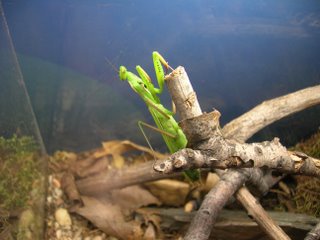
In the meantime, here's a preview of things to come, courtesy of the Insectarium's live collection:

Tuesday, August 29, 2006
Vive les papillons migrateurs!
I have a big birthday coming up soon. A very big one, in fact. One of those large, round numbers that makes people want to buy you black party hats. Or, in my case, perhaps a big red one.
My husband and I aren't normally very impulsive people, but on his own Very Big Birthday about seven weeks ago, we flew out to his hometown and celebrated with my in-laws. My ceremonial birthday visit to my own relatives will be less elaborate, and has been scheduled for a future weekend. So, he felt it was only fair to semi-impulsively line up a big trip for my own big day.
So he's going to take me to a place where I've always wanted to go.
The big question: Where do you take an antenna-head for a romantic whirlwind birthday getaway?
Well, provided our promised wireless-internet access holds up during the trip, Stridulations will be blogging from just such a place in the very near future.
The Insectarium de Montréal.
During the Monarch Odyssey.
I couldn't have picked a better birthday. Or a better husband!
My husband and I aren't normally very impulsive people, but on his own Very Big Birthday about seven weeks ago, we flew out to his hometown and celebrated with my in-laws. My ceremonial birthday visit to my own relatives will be less elaborate, and has been scheduled for a future weekend. So, he felt it was only fair to semi-impulsively line up a big trip for my own big day.
So he's going to take me to a place where I've always wanted to go.
The big question: Where do you take an antenna-head for a romantic whirlwind birthday getaway?
Well, provided our promised wireless-internet access holds up during the trip, Stridulations will be blogging from just such a place in the very near future.
The Insectarium de Montréal.
During the Monarch Odyssey.
I couldn't have picked a better birthday. Or a better husband!
Wednesday, August 23, 2006
Here's the buzz....
Have a look here.
Sunday, August 13, 2006
The first rule of Ant Fight Club is -- You do not blog about Ant Fight Club!
Ah, yes, but I'm not a member of Ant Fight Club. I'm not even an ant. So, I'm free to blog away, and here's the latest installment of our Ant TV series. Many thanks to Rick for turning my raw footage into this short video, as well as for adding photos of his own and some original music facilitated by GarageBand clips. The "video" was all taken on our two digital still cameras, pressed into service to record the ant action.
This Tetramorium battle, by the way, has been going on outside our apartment for six days (these things usually seem to resolve within a few hours, but this one's a notable exception). If it goes on much longer, I'm going to contact Jimmy Carter. In the meantime, here are our battling neighbors, captured on camera.
This Tetramorium battle, by the way, has been going on outside our apartment for six days (these things usually seem to resolve within a few hours, but this one's a notable exception). If it goes on much longer, I'm going to contact Jimmy Carter. In the meantime, here are our battling neighbors, captured on camera.
Wednesday, August 02, 2006
Still in migratory phase
Stridulations returns from the Omni Shoreham Hotel in Washington, DC, where I'm attending the XV Congress of the International Union for the Study of Social Insects. Myrmecos, who presented a summary of some of his recent research here, has reminded me that I've been remiss in the blog-upkeep department. Much of this has been due to lots of travel, both personal and professional, over the last few months.
This will be my last trip for a while, so I should be able to settle back down to a normal schedule in Rochester soon. However, this trip is a terrific way to end my summer travels before buckling down to my lab work again. First of all, the conference has been an exceptional one -- perhaps the best entomological conference I've ever attended. Second, this morning, while eating brunch in a local coffee shop with a fellow attendee, I encountered the indefatigable DC-based journalist Chris Mooney of The Intersection fame. Having also met some of the most respected names in both social-insect research and blogspace this week, I feel no need to ever go prowling for celebrities in places like Hollywood. Showbiz celebs just don't seem anywhere near as interesting to me as scientists are.
As for the title of this post: Check out this army ant resource from the California Academy of Sciences, and, of course, these photos by Myrmecos.
This will be my last trip for a while, so I should be able to settle back down to a normal schedule in Rochester soon. However, this trip is a terrific way to end my summer travels before buckling down to my lab work again. First of all, the conference has been an exceptional one -- perhaps the best entomological conference I've ever attended. Second, this morning, while eating brunch in a local coffee shop with a fellow attendee, I encountered the indefatigable DC-based journalist Chris Mooney of The Intersection fame. Having also met some of the most respected names in both social-insect research and blogspace this week, I feel no need to ever go prowling for celebrities in places like Hollywood. Showbiz celebs just don't seem anywhere near as interesting to me as scientists are.
As for the title of this post: Check out this army ant resource from the California Academy of Sciences, and, of course, these photos by Myrmecos.
Tuesday, July 04, 2006
Give us your buzzes, your stings ....
Like many United States citizens, I'm descended from immigrants -- in my case, four grandparents who came here from two countries on four separate ships. So, to celebrate the Fourth of July, I thought I'd feature another set of immigrants. Like some of the most famous seventeenth-century European colonists, and also like my own grandfather circa 1900, they first landed in the Boston area and eventually left descendants in many parts of their new homeland.

I'm referring, of course, to Polistes dominulus, the European paper wasp. This species is native to Eurasia and especially common in Mediterranean Europe. The first travelers to the U.S. were spotted in the Boston area around 1978; they've probably since experienced multiple introductions, and are now all over the northern U.S., quite literally from sea to shining sea. The specimens above were photographed in a vent on the wall of an apartment complex here in Rochester, New York, but you can find them in Virginia, Michigan, Missouri, Colorado, California, and at least a double handful of other states. They've also quite happily moved into several other nations that have hosted many human immigrants; P. dominulus populations are now established in southern Canada, and have also been found in Australia and Chile.
The long-term impact of P. dominulus on native species is still unknown. They're not particularly aggressive towards other wasps, but seem to be able to out-compete some of the local species for nest spaces and other resources that support paper wasp colonies. Various research groups in the U.S. are studying the invasion; P. dominulus has commonly been used as a subject for behavioral research in its native Europe, so behavioral and molecular ecologists on this side of the Atlantic can refer to a considerable body of published work to support ongoing research.
I'll undoubtedly return to P. dominulus in the future, but will close with a photo credit. My husband Rick took today's featured photo; he's had an unusual relationship with this species since the day five or six years ago when he beat a rug against a clothesline pole in the back yard of our (then) home in southwest Michigan. The hollow pole turned out to be full of nesting wasps; rather typically for P. dominulus, they checked him out slowly in mid-air, but did not sting him. (Note: Don't try this at home.) This occurred on Rick's birthday, which happens to be on Bastille Day. No one knows for sure where the source populations of the invasion are, so maybe I should make a whimsical bet on France. Maybe, by cutting Rick some slack, the wasps were simply practicing fraternity as well as liberty (on the wing!) and equality (workers closely resemble queens). As for the Fourth of July link -- well, the French Revolution had some roots in the one that took place here, and our flags are, after all, composed of the same colors. The wasps, though, seem much more inclined to give three cheers for the yellow, orange and black.

I'm referring, of course, to Polistes dominulus, the European paper wasp. This species is native to Eurasia and especially common in Mediterranean Europe. The first travelers to the U.S. were spotted in the Boston area around 1978; they've probably since experienced multiple introductions, and are now all over the northern U.S., quite literally from sea to shining sea. The specimens above were photographed in a vent on the wall of an apartment complex here in Rochester, New York, but you can find them in Virginia, Michigan, Missouri, Colorado, California, and at least a double handful of other states. They've also quite happily moved into several other nations that have hosted many human immigrants; P. dominulus populations are now established in southern Canada, and have also been found in Australia and Chile.
The long-term impact of P. dominulus on native species is still unknown. They're not particularly aggressive towards other wasps, but seem to be able to out-compete some of the local species for nest spaces and other resources that support paper wasp colonies. Various research groups in the U.S. are studying the invasion; P. dominulus has commonly been used as a subject for behavioral research in its native Europe, so behavioral and molecular ecologists on this side of the Atlantic can refer to a considerable body of published work to support ongoing research.
I'll undoubtedly return to P. dominulus in the future, but will close with a photo credit. My husband Rick took today's featured photo; he's had an unusual relationship with this species since the day five or six years ago when he beat a rug against a clothesline pole in the back yard of our (then) home in southwest Michigan. The hollow pole turned out to be full of nesting wasps; rather typically for P. dominulus, they checked him out slowly in mid-air, but did not sting him. (Note: Don't try this at home.) This occurred on Rick's birthday, which happens to be on Bastille Day. No one knows for sure where the source populations of the invasion are, so maybe I should make a whimsical bet on France. Maybe, by cutting Rick some slack, the wasps were simply practicing fraternity as well as liberty (on the wing!) and equality (workers closely resemble queens). As for the Fourth of July link -- well, the French Revolution had some roots in the one that took place here, and our flags are, after all, composed of the same colors. The wasps, though, seem much more inclined to give three cheers for the yellow, orange and black.
Monday, July 03, 2006
Atta colombica, Barro Colorado Island
I've been away at a conference and haven't taken the time to curate more photos during the past week, but here's a little video that I took last month on Barro Colorado Island. Many thanks to my husband Rick for doing some edits that made the video a manageable size.
Saturday, June 17, 2006
Back to the bugs
The flow of photos from Panama resumes. Here are three of the same moth, a male Urania fulgens that had the misfortune to be roadkilled just outside Altos de Campana National Park. U. fulgens is a day-flying moth that strongly resembles a swallowtail butterfly. Although this one was killed by a vehicle, its wings remained mostly intact; I froze it at the STRI lab in hopes that someone will pin it and give it new life as a permanent entomological specimen.
U. fulgens from above:
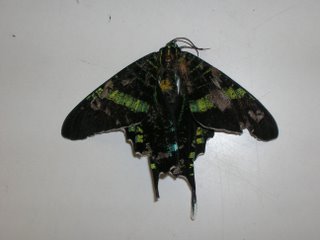
And from below, showing the underside of the wings:

One more, unfortunately a bit less sharp, but with my hand present for scale:

For more information about this beautiful moth, I'll defer to an expert, Dr. Neal Smith, whom I had the pleasure of meeting in Panama. Here's his Urania page.
U. fulgens from above:

And from below, showing the underside of the wings:

One more, unfortunately a bit less sharp, but with my hand present for scale:

For more information about this beautiful moth, I'll defer to an expert, Dr. Neal Smith, whom I had the pleasure of meeting in Panama. Here's his Urania page.
Friday, June 16, 2006
How to not survive in the woods
I'll soon return to the flow of bug photos from Panama, but have to digress briefly. If it turns out to be substantiated, this story is extremely sad on many levels.
I can completely understand someone who kills a venomous snake because it got into the back yard or the chicken coop, or because he really wants to try out Uncle Bubba's recipe for rattlesnake chili. But deliberately, needlessly attacking a non-aggressive but highly venomous snake until it's provoked to bite is -- well, I'm not sure I can come up with the proper words for it. I really hate to call a dead guy "stupid". More likely, "drunk" and "panicked" are sufficiently accurate adjectives. But if the group really had cell phones handy, why didn't they call for help? If you find a snake's presence so terrifying that you feel a need to corner the animal and beat it to death with sticks and bottles, doesn't it make some sense that you should seek help if bitten? (There's an antivenin available to treat coral snake bites; prompt treatment might well have saved this guy's life.) I don't know which was more toxic -- the snakebite itself, or the mixture of fear, ignorance, and alcohol that would cause people to get into this situation.
Venomous snakes aren't out to get us. They're also neither toys nor punching bags for confused humans. Rather, they're living organisms that bear a potent hunting weapon, which most will readily use for defense if threatened. And this sort of incident is as needlessly dangerous as it would be to escalate a minor argument between neighbors by waving loaded handguns around.
I can completely understand someone who kills a venomous snake because it got into the back yard or the chicken coop, or because he really wants to try out Uncle Bubba's recipe for rattlesnake chili. But deliberately, needlessly attacking a non-aggressive but highly venomous snake until it's provoked to bite is -- well, I'm not sure I can come up with the proper words for it. I really hate to call a dead guy "stupid". More likely, "drunk" and "panicked" are sufficiently accurate adjectives. But if the group really had cell phones handy, why didn't they call for help? If you find a snake's presence so terrifying that you feel a need to corner the animal and beat it to death with sticks and bottles, doesn't it make some sense that you should seek help if bitten? (There's an antivenin available to treat coral snake bites; prompt treatment might well have saved this guy's life.) I don't know which was more toxic -- the snakebite itself, or the mixture of fear, ignorance, and alcohol that would cause people to get into this situation.
Venomous snakes aren't out to get us. They're also neither toys nor punching bags for confused humans. Rather, they're living organisms that bear a potent hunting weapon, which most will readily use for defense if threatened. And this sort of incident is as needlessly dangerous as it would be to escalate a minor argument between neighbors by waving loaded handguns around.
Saturday, June 10, 2006
A midnight snack with friends
During the last two weeks of my recent trip, I shared a room with a marvelous colony of ants. I think they were Dolichoderus laminatus; if my identification is in error, one of my many myrmecologist friends will undoubtedly correct it, so watch this space.
I did sample a few of their number (the ants, not the myrmecologists) for experiments, but felt a bit churlish for collecting my own roommates, so almost every night I shared a bit of jam or peanut butter with them. They were exceptionally fond of my peach preserves:

In fact, they were rendered so placid by gifts of food that I was able to successfully practice my close-up shots with the new camera while they were feeding. For everyone who knew that I'd have some of the local insects eating out of my hand: You were absolutely right.
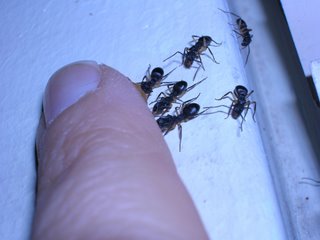
I did sample a few of their number (the ants, not the myrmecologists) for experiments, but felt a bit churlish for collecting my own roommates, so almost every night I shared a bit of jam or peanut butter with them. They were exceptionally fond of my peach preserves:

In fact, they were rendered so placid by gifts of food that I was able to successfully practice my close-up shots with the new camera while they were feeding. For everyone who knew that I'd have some of the local insects eating out of my hand: You were absolutely right.

Friday, June 09, 2006
Ant bites, captured on camera
I've finally posted some promised images to YouTube. This one shows me annoying an Azteca ant nest on Barro Colorado Island. The "videos" were actually taken with my still camera -- a tiny Coolpix 5600 that has a "movie" feature that I was using for the first time. I was alone on the trail, juggling the camera, an aspirator, and a backpack full of other collecting equipment, when I recorded them. That's why the camera angles get vertiginous sometimes. That's also how I accidentally turned off the camera during the process, which is why the encounter is divided into two separate videos, called Azteca 1 and Azteca 2. Watch them in order for maximum effect; the combined length of the two videos is a bit over four minutes. Oh, and if you really want to share the experience: Make yourself some popcorn, and sprinkle it with bleu cheese and coconut.
Wednesday, June 07, 2006
Picture time
I'm back from Panamá and very tired, but will re-start the flow of photos now that my internet connection is more reliable. These are from Ciudad de Panamá's Parque Natural Metropolitano. First of all, a typical footpath in this urban oasis:
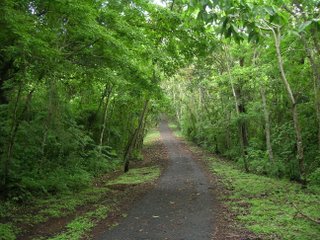
The next two photos show three things about one plant that can make you go "ouch". Fortunately, none of them actually inflicted any ouchies on me. Below is a bullthorn acacia. If you look closely, you can see not only the fierce-looking thorns, but the Pseudomyrmex ants that live there. They are reputed to have a potent sting, but my aspirator was too fast for them.

And third is this bell-shaped nest of Polybia wasps. I actually collected a few of these ladies as well, by waiting patiently with a net and nabbing them as they left or returned, but without actually jostling the nest. Unlike the Parachartergus on Barro Colorado, they weren't successful at finding my nose.
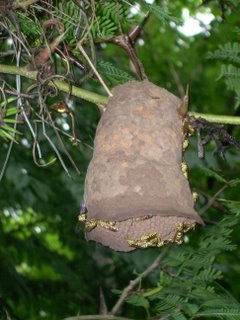

The next two photos show three things about one plant that can make you go "ouch". Fortunately, none of them actually inflicted any ouchies on me. Below is a bullthorn acacia. If you look closely, you can see not only the fierce-looking thorns, but the Pseudomyrmex ants that live there. They are reputed to have a potent sting, but my aspirator was too fast for them.

And third is this bell-shaped nest of Polybia wasps. I actually collected a few of these ladies as well, by waiting patiently with a net and nabbing them as they left or returned, but without actually jostling the nest. Unlike the Parachartergus on Barro Colorado, they weren't successful at finding my nose.

Tuesday, June 06, 2006
More as it breaks
I'll be returning to Rochester tomorrow, so the flow of photos will resume soon. In the meantime, many thanks to Don, Jennifer, Julio, Mabelle, Edgardo, Marcela, Maria, Oris, Arabella, Jeannette, and all the other researchers and support staff at Tupper, Naos, and Barro Colorado Island, who for the last three weeks have helped put the STRI in Stridulations.
Friday, June 02, 2006
Awright, who bit me?
First of all, I'm still having extreme difficulty uploading photos from my location, which is a little frustrating since I have some great bug shots lined up. It's possible that the slide show will have to be resumed after next Wednesday, when I return to the U.S. and my wireless connection.
We took a field trip yesterday to the Parque Nacional Altos de Campana, west of Ciudad de Panamá, where I saw a tremendous variety of Lepidoptera (butterflies and moths), and expanded my ant, fly, and wasp sampling. Didn't see any snakes, which I'm told are fond of many of the park trails, but I did have one altercation with an unknown bug. While walking on a trail scouting for ants and mushroom-feeding flies, I reached up to brush away something that had fallen onto my back. It immediately sank something sharp into my middle finger. I reflexively flung it into the brush, where it flapped away angrily without my getting a clear look at it. (I take full responsibility for the anthropomorphism here.)
Whatever it was, it drew blood, it hurt more than the Parachartergus wasps did, and like the former, it left me stinging all day. Since it flapped when flung, and didn't leave tooth marks, it was clearly an insect. It's possible that it was merely a nip inflicted by mandibles, but it didn't look like one, and I'm pretty sure the critter envenomated me (no swelling, but that prolonged burning and tingling was suspicious). So, I'm guessing that it was either a sting from a wasp, bee, or winged female ant, or else it was a bite from a true bug (order Hemiptera), as true bugs have piercing mouthparts. Since the predatory Hemiptera, much like spiders, inject digestive fluids into their prey, some true bugs can inflict a truly irritating bite.
Some tropical American "assassin bugs" in this order can transmit Chagas disease, although a casual bite in self-defense probably wouldn't be an effective way to do so. Infections with this disease usually happen when a bug feeds at length on an individual and defecates while taking its blood meal. This releases parasites onto the broken skin of the bite victim, who may inadvertently rub them in while scratching the bitten area.
So, if even on the outside chance that my adversary was an assassin bug, its brief attack probably hurt nothing but my finger and my entomological pride. I really wish I'd seen it, because I'd have prepared a special ethanol vial with the critter's name on it. However, after my having collected (permanently) more than a few specimens during this trip, it's probably poetic justice that I'd get chomped or stung by one that just happened by. If the leaf-litter ants were as anthropomorphic as I was in my second paragraph, they'd be laughing their little gasters off.
We took a field trip yesterday to the Parque Nacional Altos de Campana, west of Ciudad de Panamá, where I saw a tremendous variety of Lepidoptera (butterflies and moths), and expanded my ant, fly, and wasp sampling. Didn't see any snakes, which I'm told are fond of many of the park trails, but I did have one altercation with an unknown bug. While walking on a trail scouting for ants and mushroom-feeding flies, I reached up to brush away something that had fallen onto my back. It immediately sank something sharp into my middle finger. I reflexively flung it into the brush, where it flapped away angrily without my getting a clear look at it. (I take full responsibility for the anthropomorphism here.)
Whatever it was, it drew blood, it hurt more than the Parachartergus wasps did, and like the former, it left me stinging all day. Since it flapped when flung, and didn't leave tooth marks, it was clearly an insect. It's possible that it was merely a nip inflicted by mandibles, but it didn't look like one, and I'm pretty sure the critter envenomated me (no swelling, but that prolonged burning and tingling was suspicious). So, I'm guessing that it was either a sting from a wasp, bee, or winged female ant, or else it was a bite from a true bug (order Hemiptera), as true bugs have piercing mouthparts. Since the predatory Hemiptera, much like spiders, inject digestive fluids into their prey, some true bugs can inflict a truly irritating bite.
Some tropical American "assassin bugs" in this order can transmit Chagas disease, although a casual bite in self-defense probably wouldn't be an effective way to do so. Infections with this disease usually happen when a bug feeds at length on an individual and defecates while taking its blood meal. This releases parasites onto the broken skin of the bite victim, who may inadvertently rub them in while scratching the bitten area.
So, if even on the outside chance that my adversary was an assassin bug, its brief attack probably hurt nothing but my finger and my entomological pride. I really wish I'd seen it, because I'd have prepared a special ethanol vial with the critter's name on it. However, after my having collected (permanently) more than a few specimens during this trip, it's probably poetic justice that I'd get chomped or stung by one that just happened by. If the leaf-litter ants were as anthropomorphic as I was in my second paragraph, they'd be laughing their little gasters off.
Tuesday, May 30, 2006
The President of Panamá walks into a bar ….
There’s not really a punch line to the header. It’s not totally accurate, anyway, because it was a restaurant, not a bar. And I was eating dinner there at the time (Friday evening), with a group of Panamanian, American, and British acquaintances. The informality of the whole thing was surreal; except for the presence of a couple of obvious bodyguards near the door, nothing about the ambience changed. And the sad part is that it took very little red wine to render my reflexes so slow that I missed a chance to shake hands with President Martin Torrijos as he circled the room on the way out. Some of my tablemates did, though, so I’m now only one degree of separation from a head of state. (Apparently the place is one of President Torrijos’s favorites; one of my tablemates had encountered him there before.) I’m trying to imagine a similar scene in the U.S., but I just can’t.
I have bug photos in the pipeline, but Blogger's upload feature is taking more time than I have free. So, more later.
I have bug photos in the pipeline, but Blogger's upload feature is taking more time than I have free. So, more later.
Friday, May 26, 2006
A day at the bench
Not much to report today, since I'm sorting insects in the lab. (The sheer size of many of the critters here makes keying a much easier task, of course.)
During my time on Barro Colorado, I did encounter quite a few reproductive swarms of ants and termites. Although I don't really think the insects can understand human languages, I'd appreciate it if someone with a good grasp of Spanish could translate: Who are you, and why are you de-alating yourself in my fruit salad?
During my time on Barro Colorado, I did encounter quite a few reproductive swarms of ants and termites. Although I don't really think the insects can understand human languages, I'd appreciate it if someone with a good grasp of Spanish could translate: Who are you, and why are you de-alating yourself in my fruit salad?
Thursday, May 25, 2006
Buzz off, lady
24 May 2006
I’m now in Ciudad de Panamá, where I’ll spend the next two weeks sorting insects, exchanging notes on molecular work with our collaborating lab, and, with luck, planning both some field trips and some recreational exploration. My week on BCI has caught up with me much more effectively than I’ve caught up with it; that is, I did more physical labor on the island than I’ve probably done in any previous single week of my life, and my body is now attempting to shut itself down for repairs. This will be a very early night.
Two notable things today. One is that my low capacity for spatial navigation, combined with fatigue, caused me to take a wrong turn out of the winding lot of the dorm and spend a frustrating twenty minutes trying to navigate myself to the lab (it’s supposed to be a ten-minute walk). Fortunately, that was the turn that got me lost in a nice neighborhood instead of a dicey one, and I was able to communicate well enough in my primitive Spanish to a local resident for him to hail me a cab with a friendly driver. (The driver had a cuddly stuffed toy spider hanging from his rearview, and when I smiled and said “¡Me gustan las arañas!” it not only broke the ice, but clarified that I must be going to the Smithsonian lab, where I arrived only fifteen minutes late.)
The second notable thing happened in the outdoor courtyard of the STRI cafeteria, where I had lunch with my faculty host. The heat has knocked back my appetite a bit, and I was picking at my salad plate when a honey bee suddenly landed on my tray and began licking the inside of my espresso cup. I expressed my surprise that a bee would go for a sugar source that was so heavily caffeinated, and Don said, offhandedly, “That’s a killer bee.”
“Did you say ‘killer bee’?”
“Yes, all the honey bees here are Africanized now.”
A second bee had arrived and began to inspect the pineapple chunks in my salad plate. Both bees then started to buzz around my head.
“Don, what would you suggest I do?”
“Just ignore them. And don’t ingest them.”
One of the bees started to crawl on my hand, about an inch below the spot where two Parachartergus wasps had stung me a couple of nights back.
“Oh, and don’t crush any. The nest is probably in that tree over there.”
Both bees returned to my coffee cup and resumed sipping. I figured that I’d better observe Don’s second safety rule and eat the salad before they returned. By the time I was done, the bees had become sufficiently bored with my coffee to circle my head twice more and leave.
And, yes, I did drink the coffee afterwards. First of all, I needed the caffeine. And, second, the day I become too squeamish to share an espresso with two killer bees is the day I hang it up and return to a career in computer support.
I’m now in Ciudad de Panamá, where I’ll spend the next two weeks sorting insects, exchanging notes on molecular work with our collaborating lab, and, with luck, planning both some field trips and some recreational exploration. My week on BCI has caught up with me much more effectively than I’ve caught up with it; that is, I did more physical labor on the island than I’ve probably done in any previous single week of my life, and my body is now attempting to shut itself down for repairs. This will be a very early night.
Two notable things today. One is that my low capacity for spatial navigation, combined with fatigue, caused me to take a wrong turn out of the winding lot of the dorm and spend a frustrating twenty minutes trying to navigate myself to the lab (it’s supposed to be a ten-minute walk). Fortunately, that was the turn that got me lost in a nice neighborhood instead of a dicey one, and I was able to communicate well enough in my primitive Spanish to a local resident for him to hail me a cab with a friendly driver. (The driver had a cuddly stuffed toy spider hanging from his rearview, and when I smiled and said “¡Me gustan las arañas!” it not only broke the ice, but clarified that I must be going to the Smithsonian lab, where I arrived only fifteen minutes late.)
The second notable thing happened in the outdoor courtyard of the STRI cafeteria, where I had lunch with my faculty host. The heat has knocked back my appetite a bit, and I was picking at my salad plate when a honey bee suddenly landed on my tray and began licking the inside of my espresso cup. I expressed my surprise that a bee would go for a sugar source that was so heavily caffeinated, and Don said, offhandedly, “That’s a killer bee.”
“Did you say ‘killer bee’?”
“Yes, all the honey bees here are Africanized now.”
A second bee had arrived and began to inspect the pineapple chunks in my salad plate. Both bees then started to buzz around my head.
“Don, what would you suggest I do?”
“Just ignore them. And don’t ingest them.”
One of the bees started to crawl on my hand, about an inch below the spot where two Parachartergus wasps had stung me a couple of nights back.
“Oh, and don’t crush any. The nest is probably in that tree over there.”
Both bees returned to my coffee cup and resumed sipping. I figured that I’d better observe Don’s second safety rule and eat the salad before they returned. By the time I was done, the bees had become sufficiently bored with my coffee to circle my head twice more and leave.
And, yes, I did drink the coffee afterwards. First of all, I needed the caffeine. And, second, the day I become too squeamish to share an espresso with two killer bees is the day I hang it up and return to a career in computer support.
Tuesday, May 23, 2006
Wasps 3, Julie 1
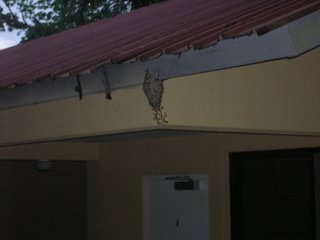
These ladies live just over the dormitory room where I've spent the past week. I decided to take a sample of them last night. Unfortunately, the wasps got more replicates of me than I did of them.
At one point I actually had a half-dozen or so in my net, but they were so adamant about making me leave the area that I lost all but one. When these wasps get ticked off, they grab whatever parts of you they can reach -- fingers and noses seem to be favorite targets -- and inflict annoying little stings that prickle and burn for at least several hours. So, I've decided to assume that the Wolbachia infection status of my lone specimen will reflect that of her sisters. I've also decided to assume that everyone who advises against swinging an aerial net too close to a nest of Neotropical vespids is correct, and should be heeded.
I'll be leaving Barro Colorado Island today for the main STRI site in Ciudad de Panamá; more as it breaks.
Monday, May 22, 2006
I love the smell of ants in the morning....
I've come to some understanding, I think, with dolichoderine ants, while collecting several species on the island over the last few days.
I can identify ants to subfamily with a microscope, and to genus with a good key, but my vision isn't super-sharp, and a lot of the ants here in the tropics are completely new to me. Included among these ants are many that can deliver a potent sting, and as much as I like Hymenoptera, I prefer not to get myself envenomated, so I handle all unfamiliar ants with care. Fortunately, I don't always have to rely on vision alone. Dolichoderines don't sting, but many of them are aggressive, nervous little biters, and members of this family are also notorious for giving off strong-smelling secretions. (We encountered some Iridomyrmex in Australia that smelled like toluene.) So, when you stir up a dolichoderine nest, you get sprayed with potent ant gas and pinched by a whole lot of mandibles.
In one major group of dolichoderines, riled-up ants give off a strong scent of bleu cheese and coconut. So, when I approach a nest or trail of unfamiliar ants, I'll handle them with forceps or an aspirator. If I start smelling (or, while using an aspirator, tasting) bleu cheese and coconut, I know I've got dolichoderines. This means two things. One, they can't sting me. Two, if I stick my fingers into the nest or trail, so many will bite me that it's a reasonably easy task to scrape them off into an alcohol vial. That is, if I can get the mandibles unlocked. Some of them bite so firmly that they hang on even when dead.
I've had to not only collect dolichoderines, but use some of them for parasite bait. So, it seems only fair that I've been using myself for ant bait from time to time. And, at this point, the early afternoon rain has stopped, so I'm going to go annoy some leafcutter ants for what will probably be my last field experiment on BCI. Leafcutters are myrmicines (not dolichoderines), so there will be no bleu cheese or coconut involved. In fact, although many myrmicines sting, leafcutters don't. So I expect a mellow experience, although the ants may have a different opinion.
I can identify ants to subfamily with a microscope, and to genus with a good key, but my vision isn't super-sharp, and a lot of the ants here in the tropics are completely new to me. Included among these ants are many that can deliver a potent sting, and as much as I like Hymenoptera, I prefer not to get myself envenomated, so I handle all unfamiliar ants with care. Fortunately, I don't always have to rely on vision alone. Dolichoderines don't sting, but many of them are aggressive, nervous little biters, and members of this family are also notorious for giving off strong-smelling secretions. (We encountered some Iridomyrmex in Australia that smelled like toluene.) So, when you stir up a dolichoderine nest, you get sprayed with potent ant gas and pinched by a whole lot of mandibles.
In one major group of dolichoderines, riled-up ants give off a strong scent of bleu cheese and coconut. So, when I approach a nest or trail of unfamiliar ants, I'll handle them with forceps or an aspirator. If I start smelling (or, while using an aspirator, tasting) bleu cheese and coconut, I know I've got dolichoderines. This means two things. One, they can't sting me. Two, if I stick my fingers into the nest or trail, so many will bite me that it's a reasonably easy task to scrape them off into an alcohol vial. That is, if I can get the mandibles unlocked. Some of them bite so firmly that they hang on even when dead.
I've had to not only collect dolichoderines, but use some of them for parasite bait. So, it seems only fair that I've been using myself for ant bait from time to time. And, at this point, the early afternoon rain has stopped, so I'm going to go annoy some leafcutter ants for what will probably be my last field experiment on BCI. Leafcutters are myrmicines (not dolichoderines), so there will be no bleu cheese or coconut involved. In fact, although many myrmicines sting, leafcutters don't. So I expect a mellow experience, although the ants may have a different opinion.
Sunday, May 21, 2006
Bugs of the day, Barro Colorado Island
Seen around the place, last night and this morning. None of these critters were collected or otherwise harmed -- at least not by me.
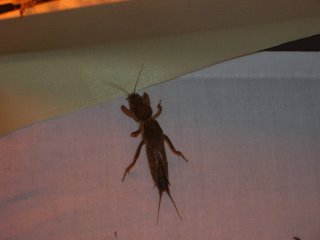
This mole cricket (Gryllotalpidae) came to a light last night. I didn't realize these things were such good fliers -- or such strong biters.
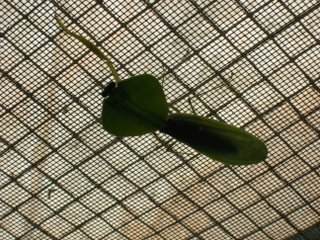
This cute green mantid was perched on a screen at the Barro Colorado Island visitor's center...
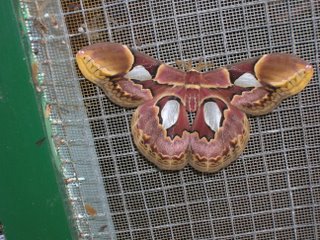
... as was this giant wild silkmoth (Saturniidae). The wingspan on this beauty was somewhere between 4 and 5 inches at its widest.

And, finally, to prove that I notice things other than bugs: Can you spot the amphibian in the above photo?

This mole cricket (Gryllotalpidae) came to a light last night. I didn't realize these things were such good fliers -- or such strong biters.

This cute green mantid was perched on a screen at the Barro Colorado Island visitor's center...

... as was this giant wild silkmoth (Saturniidae). The wingspan on this beauty was somewhere between 4 and 5 inches at its widest.

And, finally, to prove that I notice things other than bugs: Can you spot the amphibian in the above photo?
Saturday, May 20, 2006
Where I work (at least for this week)
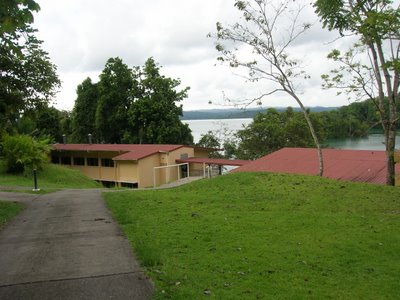
Not much science today -- just a photo of my lab building on Barro Colorado Island, with Gatun Lake in the background (crocodiles not shown).
Friday, May 19, 2006
Hundreds and hundreds of steps ....
... again today. Brought in my first mushroom baits, and set up the last ones on a trail. Also collected some ants.
I'm also hoping to bait for ant parasites, and that protocol is simple: Beat up an ant, put it into a petri dish, and wait for the parasitoid flies to go for it. Now, I've checked thousands of live insects into things from which they cannot check out -- usually ethanol vials or an ultracold freezer. Also, if you don't watch where you step here on BCI, you'll undoubtedly flatten a few leafcutters, some of them incompletely. But there's something about deliberately leaving an insect injured and helpless but alive that really distresses me. I gave the parasitoid-baiting one try, and then had to duck into my office for twenty minutes to compose myself. I think I'm going to be able to try again, but only if the bait ant is, like the Wicked Witch, not merely dead but really most sincerely dead.
Julie-rific bugs of the day: Actually, I encountered these scarabs last night. This time, my hand is present for scale.

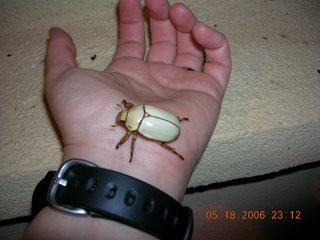
I'm also hoping to bait for ant parasites, and that protocol is simple: Beat up an ant, put it into a petri dish, and wait for the parasitoid flies to go for it. Now, I've checked thousands of live insects into things from which they cannot check out -- usually ethanol vials or an ultracold freezer. Also, if you don't watch where you step here on BCI, you'll undoubtedly flatten a few leafcutters, some of them incompletely. But there's something about deliberately leaving an insect injured and helpless but alive that really distresses me. I gave the parasitoid-baiting one try, and then had to duck into my office for twenty minutes to compose myself. I think I'm going to be able to try again, but only if the bait ant is, like the Wicked Witch, not merely dead but really most sincerely dead.
Julie-rific bugs of the day: Actually, I encountered these scarabs last night. This time, my hand is present for scale.


Thursday, May 18, 2006
Where the bugs are big, and the lizards are nervous.
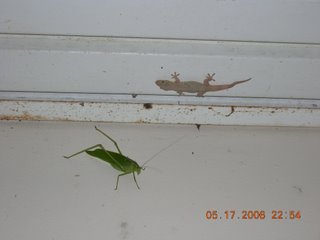
There's no ruler here to show the scale. There are also no tricks of perspective here. The gecko on the ceiling and the katydid just below it on the wall are indeed roughly the same size. I'm guessing about four inches in length for each.
Things that I saw today that refused to pose for the camera (links available through other sites):
* Two poison-dart frogs.
* Blue morpho butterflies. They keep buzzing me in the field, in fact.
* Leafcutter ants. Well, actually, I see them every day. I'll get a good picture of the little buggers yet.
For the entomologists aboard: I've been trying to collect parasitic phorid flies from the vicinity of ant colonies, so I tried sweeping over a leafcutter trail today. Didn't get many phorids, but nabbed quite a few parasitoid wasps. In fact, I was actually bemoaning not having gotten enough bugs today when I found a eucharitid wasp in the midst of my ant sweep. For those who think it looks like a scary invader from outer space: That's nothing compared to how it makes the ants feel!
Wednesday, May 17, 2006
A lab rat turned loose in the rain forest

¡Un saludo de Panamá!
Last summer, I set a number of mushroom baits in the Rochester, NY area, in order to collect fungus-feeding insects. I'm also trapping some of them here, using much the same method. The only difference: In Rochester, where I often set my baits in city parks, I could set 20 baits in about 15 minutes. Today, it took two hours, for several reasons:
* It was hot.
* It was humid.
* The trail was all uphill.
* Oh, let's face it. I kept watching bugs.
And, of course, I got off to a late start, because right after breakfast I had to go through various channels to get my laptop onto the network, and after that I made a beeline for a different trail from the one where I actually set the baits. The reason I changed trails: After I climbed 200 steep steps to the trail head, I chatted briefly with another researcher at the top of the hill, and she suggested that this trail might be a bit too steep for optimum bait-setting. So, back down I went, all the way to this dock:
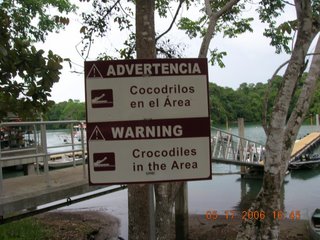
Swimming was clearly out of the question, which was too bad because it would have been nice to cool off right after I suddenly realized that I'd left my hat at the top of the hill. So, back I went, up the 200 steps, where the researcher I'd met before smiled and said, "Did you lose your hat? Because one of the maintenance guys just took it back down to the office for you."
Fortunately, by the time I got back down the steps, it was time for lunch.
The good news is that, after re-charging with fish and rice and hot sauce and mango-ginger juice, I went back out, found the other trail, and spent the aforementioned two hours setting my first ten mushroom baits. If the baits don't get eaten by the local mammals, I'll be able to sweep them tomorrow and set some more. If they do get eaten by the local mammals, I'll figure out something else to do with the next set. One way or the other, I'll probably also be annoying some leafcutter ants tomorrow, so there will be more photos. I figure I've gotten all the kinks out of the process of keeping track of all my field gear. So, at this point, I'm just going to let the ibuprofen kick in, and rest my knees until the next day's climb. There are clearly some bugs out there with my name on them!
